A good axe is one of the most useful tools to have in a workshop or when out exploring the wilderness. The basic design of axes hasn’t changed for thousands of years for one simple reason: They work. Unfortunately picking out the best axe for your needs can get complicated fast. We’ve put together a guide on the most common types of axes to help you find the one most suited for your adventures.
Contents
Axe vs Hatchet vs Tomahawk
The most basic question we get is what actually is an axe? While everyone has no doubt at least seen a wood axe you may not be aware that there are several different categories of axes.
Axe is a bit of a catch all term. Pretty much any tool with a bladed implement on a handle can be described as an axe. In general though people consider wood axes to be what we’re talking about.
This doesn’t take into account the difference between hatchets, axes, and tomahawks. Axes are the largest and most capable of the three. A hatchet is honestly just an axe that’s been shrunken down for one handed use.
A tomahawk is a little trickier. It was originally a native American tool but is now being made in a variety of different forms and materials.
Let’s dig deeper into the types of axes, hatchets, and tomahawks available.
Types of Axes
Trying to explain all the different types of axes in the world is a fool’s errand. Once you include the different specialized varieties there are too many to count. We decided to focus on 13 of the most common and effective axes out there.
These cover everything from specialized logging tools to your basic camping hatchet.
Felling Axe
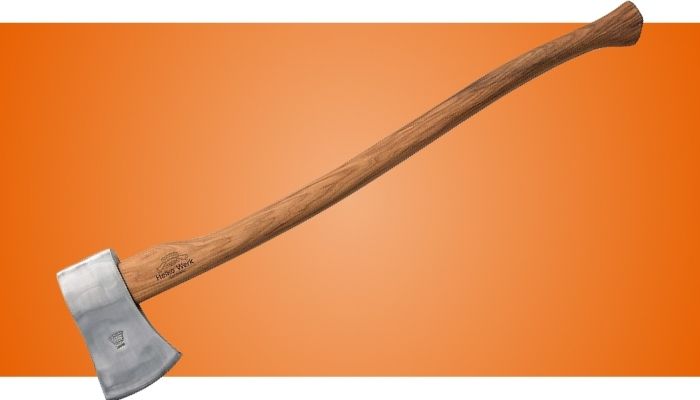
Felling axes are some of the most versatile axes available. You’ve probably used a felling axe without realizing it. They’re somewhere between a hatchet and a full size axe in size and can perform a ton of tasks efficiently.
Felling axes evolved from the wood axes that have been in use for millennia. They’re usually just under 3 feet long, have a medium sized axe head, and are designed for cutting down, or felling, trees. They allow you to put a great deal of force behind your swings while still precisely controlling where they land.
Many of the most famous makers of felling axes come from Scandinavia. They’ve been used by Swedish, Finnish, and Norwegian woodsmen for centuries. Felling axes are extremely capable, reasonably lightweight, and small enough to fit perfectly against most frame backpacks.
If you’re more of a bushcrafter than a camper you should absolutely add a high-quality felling axe to your setup.
Hatchets
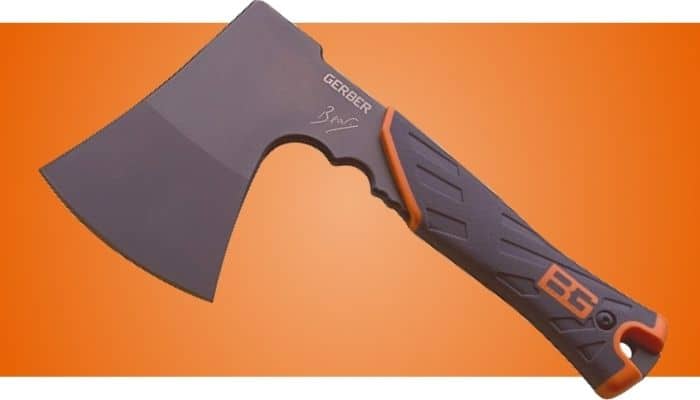
Ah hatchets, we’ve loved these pint sized tools ever since we read “Hatchet” in our youth. In most respects a hatchet is just a shrunken down axe. They’re designed to be used with a single hand and are great for smaller or more precise woodworking.
They have a smaller head, shorter handle, and a lighter weight than a full sized axe. This makes hatchets perfect tools to carry when you’re going out exploring. They can chop smallish trees, split smallish wood, and generally excel at smallish tasks.
Are they as capable as a full size axe?
Definitely not.
They do give you a ton of value for their size and are infinitely better at breaking down wood than even a large knife. See our round-up of the best hatchets currently available.
Tomahawks
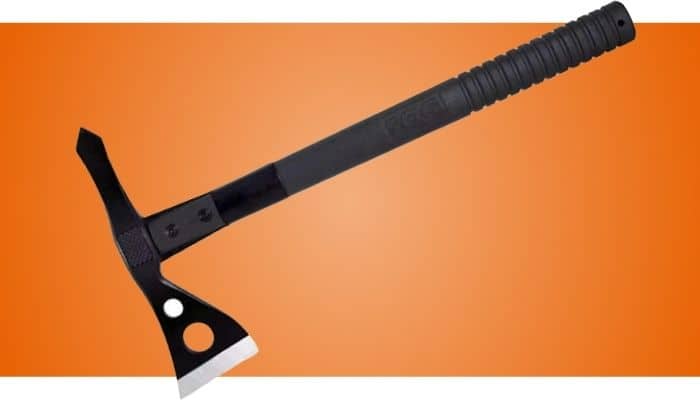
Tomahawks were originally flint and bone axes made by the native Americans. They’re characterized by a single bit and a medium length handle that’s perfectly straight. At first glance they resemble a stylized hatchet but that just scratches the surface of a tomahawk.
Modern tomahawks keep the straight handle but go for stainless steel. Many have a rounded poll for effective pounding and to add extra force to your blows.
We’ll get one thing out of the way right up front. Tomahawks aren’t really practical tools. They’ve been used for centuries as general purpose tools and weapons of war but for just about any task there’s an axe that will do the job better, faster, or easier.
That’s not to say the tomahawk has no place for the modern user. At this point they’re firmly embedded in the American image of the frontiersman/native American relationship. They can also be used fairly well as general purpose tools so long as you don’t mind putting in a little extra effort.
If a tomahawk is a tool you’re looking to buy then have a look at our best tomahawks guide.
Splitting Axes
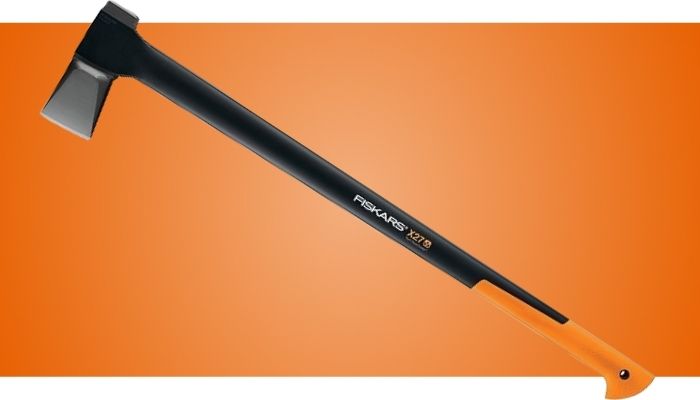
A splitting axe, also known as a splitting maul, is a heavyweight axe designed to split wood. Its most common use is for splitting logs into more manageable sized firewood. The heavy weight of the axes’ head allows you to apply a lot of downward force into the grain of the wood.
Most splitting axes have long handles with a large knob on the end. This lets you apply considerable leverage while swinging the axe without worrying about it sliding. This long handle, combined with the weight of the head, makes a splitting axe one of the least portable axes on the market.
These are great for a woodpile or a tool shed but definitely overkill for any kind of hiking or camping trip.
Double Bit Axe
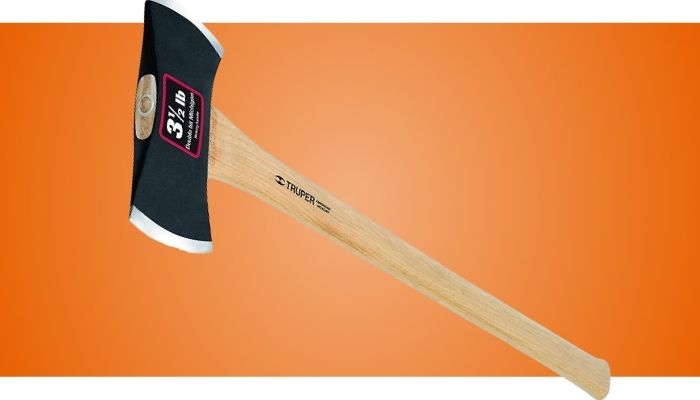
A double bit axe is what a lot of people picture when they think of a classic lumberjack. They’re large working axes with two blades or bits, one on either end. This allows you to work twice as long before you have to sharpen your axe.
Double bit axes originally had long handles and pronounced end knobs. This allowed woodsmen and loggers to put a ton of centrifugal force into their swings. More recently manufacturers have begun making double bladed ‘battle axe’ style axes.
For 99% of people a double bit axe isn’t necessary. You’re highly unlikely to ever need two fully sharpened axe blades if you aren’t a professional logger. Having two blades means they have twice as much weight. This will tire you out quickly.
They can also be dangerous if you don’t know what you’re doing. The second blade points directly back at you. One mistake can cause a lot of damage.
Viking/Dane Axe
The Viking are some of the most famous warriors that have ever lived. Known as the Dane’s among themselves they used a combination of expert seamanship and ferocious fighting methods to raid and pillage all across Europe for centuries. One of their favorite weapons was the Viking war axe.
Viking axes were much different than your standard wood axes or hatchets. Those were designed to repetitively chop through dense wood over years of work. Viking axes need only go through a bit of leather or mail and into the soft flesh beneath.
They were designed to be light and quick. Instead of the wedge shape axe bit we’re so familiar with they had a broader bit with a thinner blade.
This allowed them to move at blinding speeds and trap other weapons behind the axe head. In today’s world the Viking axe is really nothing but a curiosity. Warfare has long moved past the humble axe but many people love owning a piece of living history.
Tactical Axe
Axes have been used in warfare since there have been axes. Despite this, tactical axes are a much more recent invention. They’re mostly made by modern knife and tool companies and are designed as self-defense and survival tools.
Most pull design elements from several different types of axes. It’s not uncommon to see something as bizarre sounding as a double bit tomahawk style tactical axe. They aren’t really good for any kind of work as the blades themselves are quite lightweight and thin.
In truth though they don’t really need to be good for anything to be popular. Tactical axes are downright cool. They have interesting designs, come in a variety of exciting colors and patterns, and allow you to prepare yourself for the zombie apocalypse in style.
Battle Axe
Battle axes are what people who haven’t used an axe before picture when they think about axes. In movies and tv they’re huge double bladed things that can crush armor and cut a horse in half. The reality is a bit less dramatic.
The axe was one of the best hand to hand combat weapons available. Battle axes had large single blades and long handles. They were designed to penetrate armor and strike your enemies from a safe distance.
Many would have a warhammer built into their poll. This allowed ancient soldiers to either smash or chop their enemy’s armor (or bones) depending on their mood. Nowadays of course we have far deadlier weapons.
The battle axe doesn’t really serve a purpose anymore but it’s definitely still a really cool thing to own.
Hewing Axe
A hewing axe is a specialized tool used in processing logs and timber into lumber. They have a very broad, flat bit that lets you hew along the edges of raw logs to square them off.
In the past no settler or farmer would be caught dead without a hewing axe. It allowed them to convert logs into the lumber needed to build log cabins and all manner of useful structures.
We have lots of faster and more efficient ways to do this now but for some people the old ways will always be best. If you’ve always wanted to try your hand at log cabin building you’ll definitely need a hewing axe. Most serious woodworkers will have one as well.
Adze
An adze is a highly specialized type of axe that basically looks like a curved and sharpened hoe. The blade of an adze is perpendicular to the length of the handle and made to remove waste material and trim or shape the top surface of wood.
To use an adze you swing it in front of you to carve out sections of wood. There are several different specialized types of adzes including ones used by carpenters, builders, shipwrights, and many more.
Adzes are usually paired with hewing axes when preparing logs for use as lumber. They let you flatten then carve out the top surface of a log once it has been put in place on a frame or building project.
Carpenters Axe
Carpenter’s axes are designed to provide precision control and a very fine edge for delicate work. They’re small axes, though not quite as small as a hatchet. The blade of a carpenter’s axe is what really stands out about it. They’re quite long and extremely straight to allow you to make very clean cuts and chops.
The head of a carpenter’s axe is lighter and thinner than on similar axes. This lets you make very clean and gentle strokes that remove just the right amount of wood. This isn’t an axe to be swung about with tremendous force. You should be able to use it easily with one hand and gentle strikes.
If you’re considering taking up carpentry or woodworking as a hobby a quality carpenter’s axe should be high on your list of things to buy.
Fireman’s Axe
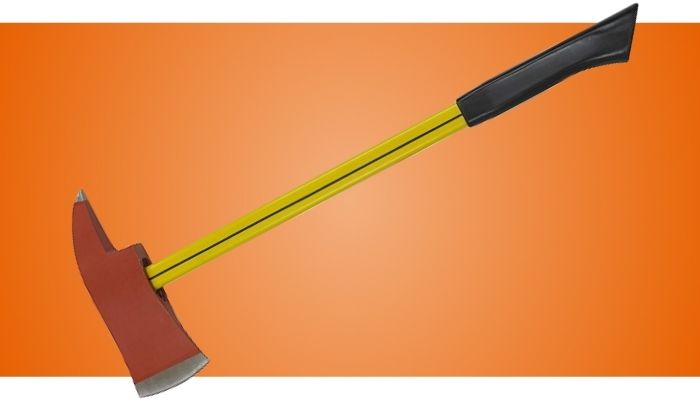
The classic fireman’s axe is an iconic part of the firefighter’s image. It’s a full size axe with a spiked bit and a long handle, often made of metal or some other fire resistant material.
Most fireman’s axes are brightly colored so as to be easy to see in an emergency. The main purpose of this kind of axe is breaking down doors and windows. The spiked poll is great for taking out locks and handles while the large bit can power through thick wooden doors.
It’s a specialized tool that you’re unlikely to need if you aren’t a firefighter.
Crash Axe
Crash axes are a highly specialized piece of equipment most people have probably never heard of. They’re included on just about every commercial plane in the sky and are designed to aid in fire suppression. Simply put a crash axe is made to cut, break, and tear cabinets and other surfaces on a plane in the event of a fire.
They can be used to help get access to a fire to put it out or as a last ditch emergency escape option. Most crash axes are made entirely of metal and have a variety of serrated, notched, and smooth cutting surfaces.
If you own a plane you probably already have a crash axe. If you don’t they’re still worth considering. They’re excellent in any emergency situation you might need to escape a room, a vehicle, or another confined space.
| More Great Gear Guides |
|---|
| 🥇 Best Camping Multi Tool |
| 🥇 Best Survival Fishing Kit |
| 🥇 Ferro Rods |
| 🥇 Folding Saws |
| 🥇 Wood Burning Stove |
Frequently Asked Questions (FAQ) – Types of Axes
As outdoor enthusiasts, it’s essential to have the right tools at hand to ensure a successful camping or hiking adventure. Among the indispensable tools is the trusty axe, a versatile companion that serves multiple purposes in the wilderness. In this FAQ section, we address some of the most common questions about the different types of axes used in camping and hiking. Whether you’re a seasoned adventurer or new to outdoor pursuits, these answers will help you understand the variations, uses, and maintenance of various axes, ensuring you choose the right tool for your needs and stay safe during your wilderness excursions.
What are the different types of axes used for camping and hiking?
There are several types of axes commonly used in camping and hiking, including camping axes, hatchets, splitting axes, and felling axes. Each type is designed for specific purposes and has unique features to cater to different outdoor activities.
What is the difference between a camping axe and a hatchet?
A camping axe and a hatchet are similar in terms of design and purpose, but the main difference lies in their size and weight. A camping axe is typically longer and heavier, making it suitable for tasks like chopping wood, while a hatchet is smaller and lighter, making it ideal for tasks that require more precision, such as cutting small branches or preparing kindling.
When should I use a splitting axe?
A splitting axe, also known as a splitting maul, is designed specifically for splitting logs. It features a heavy, wedge-shaped head that helps to split the wood along the grain. Use a splitting axe when you need to split larger logs into smaller, more manageable pieces for firewood or other purposes.
What is a felling axe used for?
A felling axe is designed for cutting down trees. It has a longer handle and a sharp, slightly curved blade that allows for powerful swings and efficient cutting. Felling axes are typically used by professional loggers or individuals engaged in forestry work.
Can I use a camping axe for self-defense?
While a camping axe can be a versatile tool in the outdoors, it is not specifically designed for self-defense purposes. It’s always recommended to carry appropriate self-defense equipment if personal safety is a concern.
How should I maintain my axe?
To keep your axe in good condition, it’s important to regularly clean and oil the blade to prevent rust. Sharpen the blade when it starts to dull, and always store the axe in a dry place when not in use. Additionally, check the handle for any signs of damage or wear and replace it if necessary.
Are there any safety precautions I should take while using an axe?
Yes, using an axe requires caution and adherence to safety guidelines. Some key precautions include wearing protective gear such as gloves and safety glasses, maintaining a firm grip on the axe, using a stable chopping surface, and keeping bystanders at a safe distance. It’s also crucial to follow proper chopping techniques to minimize the risk of accidents.
Can I use an axe for other purposes besides camping and hiking?
Axes have a wide range of uses beyond camping and hiking. They can be utilized for woodworking, bushcraft, survival situations, and even certain sports like axe throwing or timber sports. Just ensure that you use the appropriate type of axe for the specific task at hand.
Final Thoughts
This covers the most widely used types of axes available today. Whether you’re purchasing your first or your tenth axe you should always consider the basics.
What will you use the axe for?
Where will you use it?
How is the axe getting where it’s needed?
Make sure you match the portability, utility, and durability of any axe you buy to your own needs.
Good discussion about axes and hatchets. Although most I would agree with. But when u go threw 30 or more great vintage to modern top quality.axes you find one that’s better than the others ,to what brought me here I’m trying to find Information on a unknown hatchet maker who marks (A) on the Underside of the hatchet ,closer to the bit than the handle.. and when it wasn’t broke I could out fell most best full sized felling axes and I’ve had all the good brands and This one I would trade most if not al of them for another